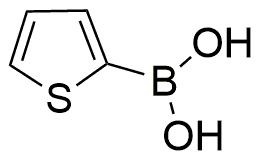2-Thiopheneboronic acid is widely utilized in research focused on:
- Pharmaceutical Development: This compound serves as a key building block in the synthesis of various pharmaceuticals, particularly in the development of drugs targeting cancer and other diseases due to its ability to form stable complexes with biomolecules.
- Organic Electronics: It is used in the fabrication of organic semiconductors, enhancing the performance of devices like organic light-emitting diodes (OLEDs) and organic solar cells, which are crucial in the electronics industry.
- Materials Science: The compound plays a significant role in creating advanced materials with unique properties, such as conductive polymers, which are essential for innovative applications in sensors and flexible electronics.
- Catalysis: 2-Thiopheneboronic acid is employed as a catalyst in various organic reactions, improving reaction efficiency and selectivity, making it valuable in chemical manufacturing processes.
- Bioconjugation: This chemical is utilized in bioconjugation techniques to attach biomolecules to surfaces or other molecules, facilitating advancements in targeted drug delivery systems and diagnostic tools.
General Information
Properties
Safety and Regulations
Applications
2-Thiopheneboronic acid is widely utilized in research focused on:
- Pharmaceutical Development: This compound serves as a key building block in the synthesis of various pharmaceuticals, particularly in the development of drugs targeting cancer and other diseases due to its ability to form stable complexes with biomolecules.
- Organic Electronics: It is used in the fabrication of organic semiconductors, enhancing the performance of devices like organic light-emitting diodes (OLEDs) and organic solar cells, which are crucial in the electronics industry.
- Materials Science: The compound plays a significant role in creating advanced materials with unique properties, such as conductive polymers, which are essential for innovative applications in sensors and flexible electronics.
- Catalysis: 2-Thiopheneboronic acid is employed as a catalyst in various organic reactions, improving reaction efficiency and selectivity, making it valuable in chemical manufacturing processes.
- Bioconjugation: This chemical is utilized in bioconjugation techniques to attach biomolecules to surfaces or other molecules, facilitating advancements in targeted drug delivery systems and diagnostic tools.
Documents
Safety Data Sheets (SDS)
The SDS provides comprehensive safety information on handling, storage, and disposal of the product.
Product Specification (PS)
The PS provides a comprehensive breakdown of the product’s properties, including chemical composition, physical state, purity, and storage requirements. It also details acceptable quality ranges and the product's intended applications.
Certificates of Analysis (COA)
Search for Certificates of Analysis (COA) by entering the products Lot Number. Lot and Batch Numbers can be found on a product’s label following the words ‘Lot’ or ‘Batch’.
*Catalog Number
*Lot Number
Certificates Of Origin (COO)
This COO confirms the country where the product was manufactured, and also details the materials and components used in it and whether it is derived from natural, synthetic, or other specific sources. This certificate may be required for customs, trade, and regulatory compliance.
*Catalog Number
*Lot Number
Safety Data Sheets (SDS)
The SDS provides comprehensive safety information on handling, storage, and disposal of the product.
DownloadProduct Specification (PS)
The PS provides a comprehensive breakdown of the product’s properties, including chemical composition, physical state, purity, and storage requirements. It also details acceptable quality ranges and the product's intended applications.
DownloadCertificates of Analysis (COA)
Search for Certificates of Analysis (COA) by entering the products Lot Number. Lot and Batch Numbers can be found on a product’s label following the words ‘Lot’ or ‘Batch’.
*Catalog Number
*Lot Number
Certificates Of Origin (COO)
This COO confirms the country where the product was manufactured, and also details the materials and components used in it and whether it is derived from natural, synthetic, or other specific sources. This certificate may be required for customs, trade, and regulatory compliance.


